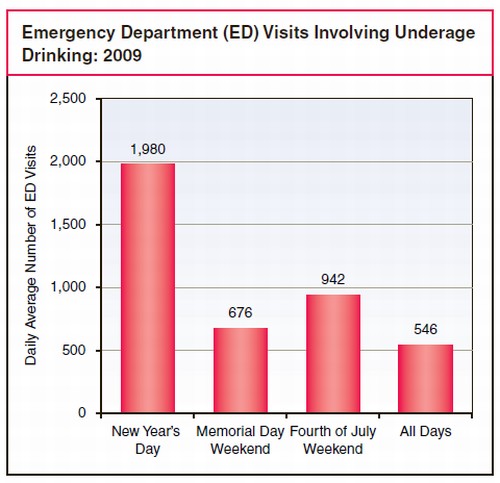Emergency Department Visits for Underage Drinking Increase on New Year’s Day
Emergency Department Visits for Underage Drinking Increase on New Year’s Day. Drinking Increase on New Year’s Day.

Risk factors for underage drinking can increase around holidays, such as New Year’s Day, Memorial Day, and the Fourth of July. Greater access to alcohol, less parental oversight, and mixed messages from parents may fuel surges in underage drinking, which can result in visits to hospital emergency departments (EDs) because of overconsumption or alcohol-involved accidents or injuries. The New Year’s holiday may be particularly risky because underage individuals may drink more than during most other times of the year, including other holidays.1
According to estimates from the Drug Abuse Warning Network (DAWN), on New Year’s Day 2009, an estimated 1,980 ED visits involved underage drinking, compared with 546 such visits on an average day that year; this represents nearly 4 times the average number of visits (Figure). The number of ED visits involving underage drinking was also generally higher on New Year’s Day than on an average day during either the Memorial Day weekend or the Fourth of July weekend.
Whereas all underage alcohol consumption is of concern, consumption that leads to ED visits on New Year’s Day should be of particular concern to parents and young people because such consumption may increase other risky behaviors. For those interested in preventing underage drinking, SAMHSA offers a variety of educational and other materials at: www.underagedrinking.samhsa.gov
* Emergency Department (ED) Visits Involving Underage Drinking: 2009
1 Del Boca, F. K., Darkes, J., Greenbaum, P. E., & Goldman, M. S. (2004). Up close and personal: Temporal variability in the drinking of individual college students during their first year. Journal of Consulting and Clinical Psychology, 72(2), 155-164.
** Source: The Drug Abuse Warning Network (DAWN) is a public health surveillance system that monitors drug-related hospital emergency department (ED) visits and drug-related deaths to track the impact of drug use, misuse, and abuse in the United States.



















